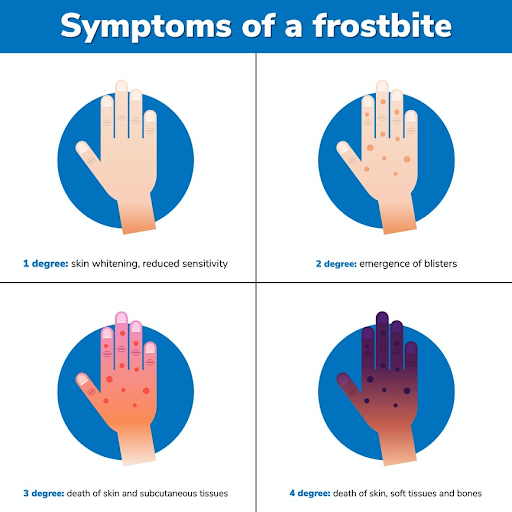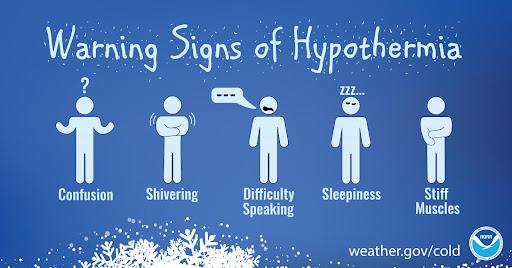Extremely cold temperatures can be hazardous especially if individuals are exposed for a prolonged period of time. Older adults, individuals with access and functional needs, and those with poor circulatory systems, may be more vulnerable to cold-related illnesses including frostbite and hypothermia. These are very serious illnesses that require immediate medical attention.
Frostbite
Frostbite is when the skin freezes due to prolonged exposure to extremely cold temperatures. Symptoms of frostbite include skin whitening, numbness, and blisters. In extreme cases the skin cells and surrounding tissue begin to die and skin may turn red and look inflamed. If the frostbite is severe enough, it may also cause the soft tissue and bone to die which causes the skin to look blue or purple. This is why it is extremely important to seek immediate medical attention for frostbite. If you notice someone with these symptoms, call 9-1-1 immediately.

Hypothermia
Hypothermia occurs when the body’s core temperature drops below 95 degrees. Severe hypothermia may occur if it drops below 82 degrees. When your body temperature drops, your heart, nervous system and other organs can't work properly and if left untreated, hypothermia can lead to heart failure, respiratory failure, and death in extreme cases. Symptoms of hypothermia include confusion, excessive shivering, difficulty speaking or confusion, sleepiness, and stiffness. If you notice someone with these symptoms, call 9-1-1 immediately.

When extremely cold temperatures occur, Anne Arundel County makes several County facilities available to community members for temporary warming relief. For more information visit www.aacounty.org/warm. For individuals that need sheltering or special accommodations contact the Crisis Warmline at (410) 768-5522.
The Anne Arundel County Office of Emergency Management encourage residents to sign up for winter weather related emergency alerts at http://alertannearundel.civicready.com/ and take the following precautions:
- Avoid prolonged exposure to extreme cold temperatures by taking breaks to warm up. This includes limiting exposure for your children and pets as well.
- Dress in layers to stay warmer for longer. This also gives you more flexibility to remove layers while still staying warm.
- Wear a warm hat when going outside. Up to 50 percent of body heat is lost through the head.
- Drink plenty of water and avoid nicotine, caffeine, and alcohol which can cause dehydration.
- Prepare for the unexpected by building an emergency go-kit. Most hypothermia cases occur due to an unexpected change in the weather or temperature, so keep extra gloves, hats, and a coat in your kit.
- Avoid getting wet when the temperatures drop and wear waterproof boots or shoes to keep your feet dry.
- Do not attempt to drive, play, or skate on an iced over body of water such as a lake or pond. The ice may not be thick enough to support your weight and extremely cold water can cause you to go into shock if you fall in.

